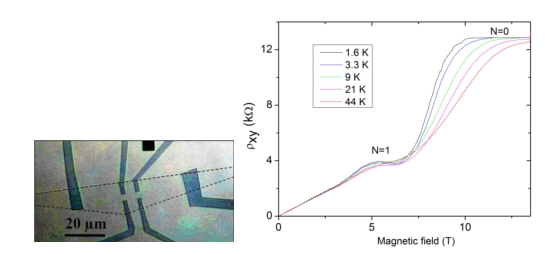Rechercher
Accueil > La Recherche > Axes & Equipes > Axes transverses > Graphène
Transport properties of epitaxial graphene on SiC
publié le
Electrical measurements performed on graphene reveal the extremely unusual nature of the carriers. The value of the conductivity at the Dirac point, which does not correspond to its theoretical expectation, is an open problem, as well as the asymmetry in the conductivity of electrons and holes. Low magnetic fields studies reveal the presence (or the absence !) of quantum interferences, leading to positive and negative magnetoresistances. The positive magnetoresistance (also known as weak antilocalization) is a direct sizable consequence of the absence of backscattering for the Dirac particles. In high magnetic fields, in the quantum limit, Landau levels form at energies following a law in B1/2 - the first Landau Level being stuck at the Dirac point. At even higher fields, some evidences for unusual fractional quantum Hall effect (with anomalous fractions) have been reported. These unfamiliar characteristics are far from being completely understood or explored. Nevertheless, applications already are targeted : metrology (as the Quantum Hall effect in graphene persists up to room temperature) ; TeraHertz generation ; gas sensors ; supercapacitors ; even tactile touch screens.

Currently a large part of our activity is focussed on the physical properties of epitaxial graphene layers. How large can be the layers ? How they interact with the substrate ? Device fabrication largely uses clean room facilities. Transport measurements are routinely done in large magnetic fields (up to 14T) in a large range of temperatures (50mK-300K). We have at disposal four variable temperature insets (1.5K- 300K), one He3 inset, a small He3/He4 dilution unit, resistive magnets (0.3T ; 1T) ; cryostats shipped with superconducting magnets (3T ; 9T and 14T).








